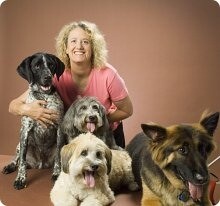Dog Days

It's been more than six months since Cathy Rubin died. Just writing the words and reading them back to myself feels strange and transgressive, a violation of Cathy's longtime mission of giving life and security to dogs who were almost certainly doomed to perish on the streets or in overcrowded animal shelters that have only gotten more overcrowded in this recession.
In the face of such need, Cathy's own death hardly seemed possible. When she succumbed to cancer last Christmas, it seemed like an extraordinary and singular event that was somehow part of the holiday season: after the beginning of the new year, these events would be wrapped up and put away and things would return to normal. She would get back to work.
Incredibly, she hasn't. After expecting her to show up through winter and spring, I had to admit defeat and go on to the business of remembering. That I knew Cathy at all was an anomaly, a quirk in the usual fated isolation of Angelenos living in different cities and demographics, in this case Inglewood and Redondo Beach. Pragmatic but eternally upbeat, Cathy was literally a den mother for the tens of hundreds of dogs who passed through Rover Rescue, her rescue-and-adoption operation run out of her home in Redondo. I met her back in 2006, when I was inspired to adopt a dog after seeing how so many evacuees of Hurricane Katrina were forced to leave their pets behind in the storm. I couldn't imagine; I hadn't had a dog since I was 20 and still in college, but I always had an affinity for them that went beyond warm fuzzies most of us feel to some degree for animals, especially those with paws and whiskers.
It was that affinity that broke through the Southland segregation and led me to Cathy. Of course we weren't that far apart geographically, but the fact was that I knew very few people living in any South Bay city tonier than Gardena. Redondo was one of those places I visited, though not in any meaningful way--the South Bay Galleria mall on the occasional Saturday. But I didn't know its inner life; it never seemed necessary. Cathy was a window onto that life. She grew up around Hermosa and Redondo, became a clincial psychologist who eventually gave that up because she realized fairly early in that career that her greater passion was saving dogs. I was proud to officially become a part of that passion, to pitch in and walk the RR dogs being boarded at a vet in Inglewood (my husband and I became the informal Inglewood reps; we still are). I also sometimes volunteered to work the regular adoptions at the Centinela pet supply deep in Redondo on PCH; I felt needed in a part of town that certainly had never needed me before. As the sole black participant at these events, I never lost sight of how unusual my presence there was. I'm sure other people didn't either. But there was no denying that dog rescue had instantly given me a community across the usual racial, political and physical barriers that felt like nothing less than magic. Cathy was the conduit to it all.
And now I'm realizing I will have to be a conduit myself. This past Monday, on Fourth of July, I did a fundraising walk for Rover down in Redondo Beach, near the water's edge. I took two of my dogs, Honey and Maude, both Rover Rescue alums. The early morning was pleasant, if a bit muggy. I had never walked in town so long before; when I was done I took a team photo with fellow RR walkers, had bagels and peanut butter. It was all very sunny and Mayberry-ish, hardly my usual activity or orientation. But it is unquestionably part of my life. I don't live here, but I am no longer on the outside. Like Cathy did so well, I will have to do this part of my life justice from now on.


